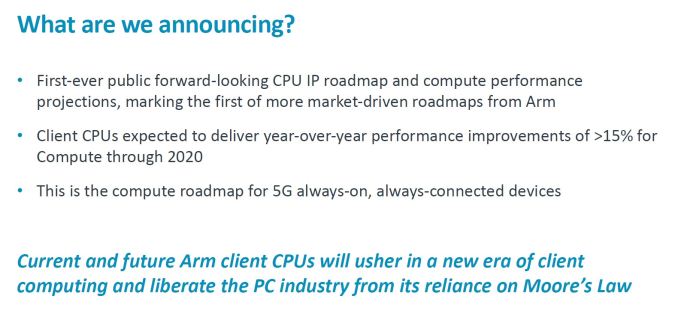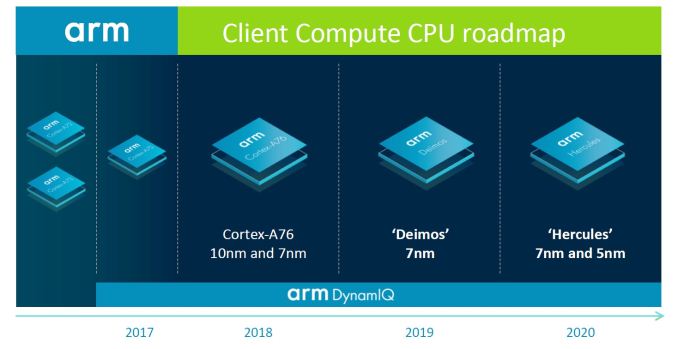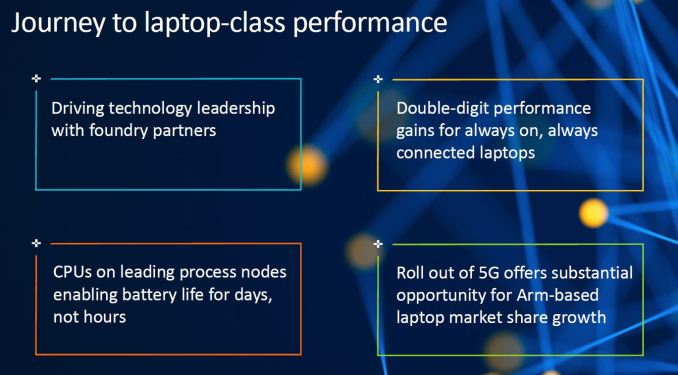Arm Unveils Client CPU Performance Roadmap Through 2020 - Taking Intel Head On
by Andrei Frumusanu on August 16, 2018 9:05 AM EST
Today’s announcement is an oddball one for Arm as we see the first-ever public forward looking CPU IP roadmap detailing performance and power projections for the next two generations through to 2020.
Back in May we extensively covered Arm’s next generation Cortex A76 CPU IP and how it’s meant to be a game-changer in terms of providing one of the biggest generational performance jumps in the company’s recent history. The narrative in particular focused on how the A76 now brought real competition and viable alternatives to the x86 market and in particular how it would be able to offer performance equivalent to Intel’s best mobile offerings, at much lower power.
Arm sees always-connected devices with 5G connectivity as a prime opportunity for a shift in the laptop market. Qualcomm’s recent Snapdragon 835 and Snapdragon 850 platforms were the first attempts in trying to establish this new slice for Arm-based PCs.
Today’s roadmap now publicly discloses the codenames of the next two generations of CPU cores following the A76 – Deimos and Hercules. Both future cores are based on the new A76 micro-architecture and will introduce respective evolutionary refinements and incremental updates for the Austin cores.
The A76 being a 2018 product – and we should be hearing more on the first commercial devices on 7nm towards the end of the year and coming months, Deimos is its 2019 successor aiming at more wide-spread 7nm adoption. Hercules is said to be the next iteration of the microarchitecture for 2020 products and the first 5nm implementations. This is as far as Arm is willing to project in the future for today’s disclosure, as the Sophia team is working on the next big microarchitecture push, which I suspect will be the successor to Hercules in 2021.
Part of today’s announcement is Arm’s reiteration of the performance and power goals of the A76 against competing platforms from Intel. The measurement metric today was the performance of a SPECint2006 Speed run under Linux while complied under GCC7. The power metrics represent the whole SoC “TDP”, meaning CPU, interconnect and memory controllers – essentially the active platform power much in a similar way we’ve been representing smartphone mobile power in recent mobile deep-dive articles.
Here a Cortex A76 based system running at up to 3GHz is said to match the single-thread performance of an Intel Core i5-7300U running at its maximum 3.5GHz turbo operating speed, all while doing it within a TDP of less than 5W, versus “15W” for the Intel system. I’m not too happy with the power presentation done here by Arm as we kind of have an apples-and-oranges comparison; the Arm estimates here are meant to represent actual power consumption under the single-threaded SPEC workload while the Intel figures are the official TDP figures of the SKU – which obviously don’t directly apply to this scenario.
We didn’t have internal data to verify Arm’s claims as of publishing of the article, but the 15W Intel figure is naturally on the high side, given that this just the official TDP representing multi-threaded workloads – a very quick test of CB15 ST power as reported by MSR registers on an 7200U at 3.1GHz measured 9.3W package+DRAM power while an 8250U at 3.35GHz came in at 11W. I haven’t correlated SPEC power on x86 to date, but I’m expecting it on average to be less than CB15. Even if the 15W figure for the 7300U is correct, and I’m expecting something more in the range of 9-11W, Arm might be using one of Intel’s notably less efficient performance points when doing the comparison for these SKUs. Of course this doesn’t invalidate the data as efficiency for the A76 at those frequencies would also not be optimal, it’s just something to keep in mind.
It’s also interesting to see Arm scale back on the performance comparison as they’re using a 3GHz A76 as the comparison data-point – this is in contrast to the 3.3GHz maximum 5W performance point presented during TechDay. I had tried to estimate the A76’s power in mobile form-factors based on the different metrics Arm disclosed and came at an estimated 2.3W at 3GHz. Naturally Arm says “less than 5W” and they could be erring on the safe side of not over-promising – but if it had been *that* much lower, as in my estimate, we would have maybe seen even more aggressive marketing figures. In the end, until we get the first A76 devices in our hands, we won’t know for sure what the exact figures will be and at which point on the efficiency curve Arm’s projected 3GHz performance figures will end up at.
The last slide that is notable to talk about is the performance projections for Deimos and Hercules. Here Arm’s taking a direct stab at Intel’s lack of significant progress over the last few years and reiterating its confidence in the company’s ability in sustaining high CAGR (compound annual growth rate) performance figures for the next generations.
Again at TechDay we quoted figures of 20-25% while today’s announcement contained a more conservative figures of “>=15%” – likely better representing a seemingly larger 20% projected boost for Deimos as well as what seems to be a 10% gain for the 5nm follow-up Hercules. Taking into account the relative positioning of the data-points in this chart, I did some quick correlation and it matches my initial estimated performance figures for a 3GHz A76 at around ~26 SPECint2006. Deimos and Hercules would come in at figures of ~31 and ~34 points.
Finally today’s announcement is a marketing exercise attempting to emphasise Arm’s performance and power commitments over the next few generations, trying to showcase it has the strategy and technology in place to make the Arm laptop market a real growth opportunity. If and how this pans out is something that we won’t find out at least until later on in the year, with the first actual A76 based large form-factor designs not being a thing until at least sometime in 2019. We’re eagerly awaiting the first A76 based mobile designs in the months to come and to have a first hand-on evaluation of the new microarchitecture family.















102 Comments
View All Comments
Wilco1 - Thursday, August 16, 2018 - link
Applications that already struggle to run correctly on x86 won't be popular so we can discount those as not being relevant. What is left are popular old applications/games which are no longer under active development. Due to being old they will have low CPU requirements and thus run more than fast enough.HStewart - Thursday, August 16, 2018 - link
So far the problem has only been with GPU - for me it with AMD GPU in my XPS 15 2in1Gamer's will always keep x86 base computers a live. Even the console more toward x86 chips.
Great_Scott - Thursday, August 16, 2018 - link
The future doesn't come from dominating the current standards, it comes from making them irrelevant.Truly Intel ST performance ARM processors won't need to run x86 code because we'll be getting all our (desktop) Apps from Google Play.
TheJian - Thursday, August 16, 2018 - link
Not sure what the holdup is on NV pushing this well beyond just a few models of Qcom's chips. NV should be all over this to get their mobile platform finally brought back into the fold. They were just ahead of their time for 5yrs, but gaming is there now and a major attraction. Put out a 7nm soc with Intel wireless and see what happens, while also putting out new versions of your handheld and android tv boxes with DOUBLE socs in thim hitting 100w-200w total and a replacable PSU that can be upgraded for a full 2080ti card coming soon :) A console that is TRULY lowend vid box with best features, OR maxed out gaming console the doubles as that low end vid box.Translation of code doesn't take 40-50% hits today. Even old FX32 (IIRC) rand Intel code pretty dang fast for PROe etc. They used it mainly instead...LOL. More stable etc.
mukiex - Thursday, August 16, 2018 - link
To be fair, Microsoft's already been working on a translator since that one experient with the Snapdragon 845. If there's a use case for them (an ARM-based Surface tablet?), they could very well put a lot of dev time into it.https://docs.microsoft.com/en-us/windows/uwp/porti...
surt - Friday, August 17, 2018 - link
I don't know ... if you're a productivity person you compile linux and all your apps these days are on javascript. If you don't play games you don't really need x86 compatibility anymore.lartech - Thursday, February 28, 2019 - link
"emulation which is a lot slower than running it with [native] x86" -- I take strong exception to this native, blanket statement. You assume that *all* x86 code has to be painstakingly emulated, yet most of the time, it *doesn't*. Often, most of an application's runtime is spent in libraries and system calls, which can be run *natively* on the host processor, no emulation required. (as an example, have you ever heard of the "Wine" Windows emulator?)I've talked to people who own the new crop of Windows laptops running on Qualcomm Snapdragon (Arm-based) processors. They overwhelmingly find the performance just fine -- even when running 3rd-party apps that use x86-native binaries. Obviously some x86 apps take a performance hit, but for normal "desktop productivity" apps, they don't find it that noticeable. And the far longer battery life and always-on 4G connectivity seem to be worth the cost of a small degradation in some x86 apps. One of them said that he can literally run his Arm-based laptop for _days_ without recharging it and some days doesn't even bother to bring a charger with him to work.
Santoval - Wednesday, December 18, 2019 - link
I don't think Arm want a x86 license. They are a SoC design company, so if they got a x86 license they would need to ditch their own ARM ISA. They can either emulate x86, in coordination with Qualcomm and MS (like they do now) or switch their CPUs to that ISA, which would render them yet another x86 CPU / SoC company.I don't think there is something in between they can do (e.g make their SoCs truly dual mode and run both ARM and x86 in hardware; that would be stupid). The ARM ISA is Arm's strongest asset. They make their money from licensing it and their SoC designs based around it. So why would they just ditch it and hand Intel such a huge win? Arm have no incentive to license x86, unlike Nvidia.
jjj - Thursday, August 16, 2018 - link
Why would they share this info as a good thing?Hitting 5W at 3GHz with single core loaded means what when all 4 cores loaded?
And the way they make the 15%+ claim, suggests it includes process.
Are they trying to make us less excited?
If they would be advertising 2x the cores at half the price and same ST perf, ok we can swallow that but nobody is making those SoCs.
They are focusing on the wrong thing, in consumer they should focus on glasses and show us what they can do at 50mW not 5W. They should focus on killing the PC. I suppose PC is server adjacent and that's enough of an excuse but it really isn't a market with a future.
Andrei Frumusanu - Thursday, August 16, 2018 - link
> Hitting 5W at 3GHz with single core loaded means what when all 4 cores loaded?It means it'll be 15-18W. Arm didn't make any MT comparisons because the decision on how many cores to actually put into an SoC will be up to the actual SoC vendor.